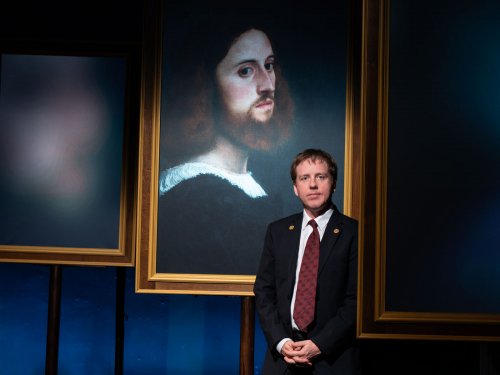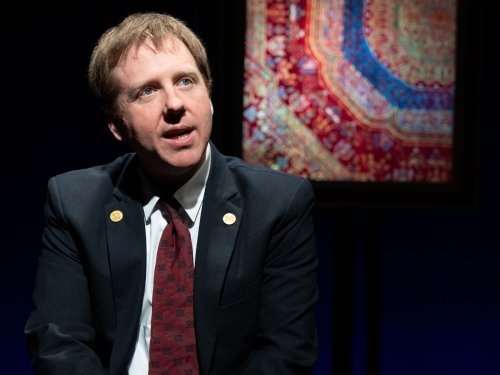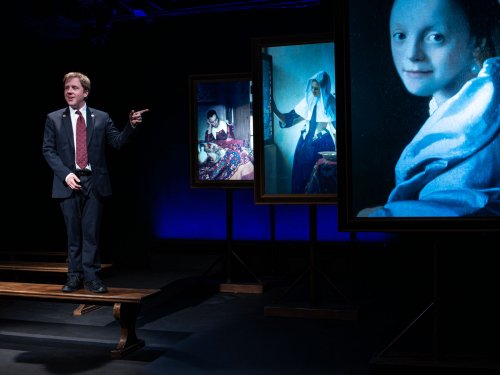All the Beauty in the World
Patrick Bringley’s memoir, first a moving book and now a work for the stage, reminds us that we look to art to provide inspiration as well as solace.

Patrick Bringley in his one-man show “All the Beauty in the World” at the DR@ Theatre (Photo credit: Joan Marcus)
“Grief is, among other things, a loss of rhythm,” muses Patrick Bringley in All the Beauty in the World—a line that lingers like a low note in this quietly resonant one-man show, now unfolding on the intimate stage of the DR2 Theatre. Adapted from Bringley’s 2023 memoir, the play is both an elegy and an inward journey, tracing the contours of mourning through the eyes of a man in his twenties, reeling from the death of his older brother.
Bringley, making his theatrical debut as himself, delivers a performance marked by restraint and quiet intensity. His words, drawn largely from the memoir, reveal a man of thoughtfulness and delicacy—someone who seeks refuge not in action, but in observation, retreating to the hushed galleries of The Metropolitan Museum of Art, where he once worked as a guard. “You lose someone,” he tells us, simply, “and it puts a hole in your life—and for a time you huddle down in that hole.” It’s in that stillness, that huddling, that the piece finds its quiet power.
All the Beauty in the World doesn’t clamor for attention; it listens, lingers, and allows space for breath. Like the art it reveres, it asks the audience not for answers, but for presence. And in a world that often rushes past pain, Bringley offers a brave and beautiful pause.

Patrick Bringley in his one-man show “All the Beauty in the World” at the DR@ Theatre (Photo credit: Joan Marcus)
At the play’s opening, we find Patrick ensconced in the highbrow hustle of The New Yorker, contributing to the magazine’s annual festival—a symbol of intellectual prestige and curated ambition. But when his brother Tom, a brilliant PhD candidate navigating the intersection of biology and mathematics, is suddenly diagnosed with an aggressive cancer, the rhythm of Patrick’s life fractures. The Bringley family closes ranks in quiet solidarity, a portrait of grief rendered with restraint. Two years later, after Tom’s death, Patrick’s rejection of the upwardly mobile, image-driven culture he once inhabited feels both inevitable and profound. “I had lost someone,” he says with aching simplicity. “I did not wish to move on from that. In a sense, I didn’t wish to move at all.” It’s a moment that lands not as a line of dialogue, but as an emotional full stop—the kind that reverberates long after the scene fades.
The play begins not with a bang, but with a retreat: Patrick, weary from the relentless churn of New York’s professional class, exchanges the clangor of deadlines and branding for the hushed grandeur of The Metropolitan Museum of Art. There, as a modestly paid security guard, he finds both sanctuary and purpose. Amid the stillness of the galleries—“a place that seem[s] uniquely untouched by the rhythms of the everyday”—he tends not just to the artworks, but to his own grief. What begins as a pause from life becomes a decade-long immersion in beauty, silence, and slow self-repair.
On paper, All the Beauty in the World might sound like a theatrical long shot: a one-man show, adapted from a memoir, performed by a non-actor. Yet under the sensitive and assured direction of Dominic Dromgoole—veteran of Shakespeare’s Globe and a master of narrative clarity—the production transcends its premise. Bringley, delivering his own story, sidesteps theatrical bravado in favor of an understated authenticity that quietly grips the audience. The script, spare but resonant, allows room for reflection without indulgence. The result is a solo performance that is not only watchable, but absorbing—a quiet meditation that lingers long after the final bow.

Patrick Bringley in his one-man show “All the Beauty in the World” at the DR@ Theatre (Photo credit: Joan Marcus)
In addition to directing, Dromgoole lends his hand to the production’s design, crafting a visually inviting and admirably restrained environment. The stage is adorned with familiar Met benches—evocative in their simplicity—and framed by three screens that serve as canvases for Austin Switser’s quietly powerful projections and Abigail Hoke-Brady’s sensitive lighting design to complement it. These shifting images, drawn from the museum’s collection, are more than mere backdrops; they act as silent co-narrators, deepening the emotional and thematic texture of the piece.
Though the script wisely avoids turning the evening into an art history lecture, it weaves in sharp, accessible reflections on the projected artworks—observations that reveal a keen eye without ever veering into pedantry. Bringley’s commentary, clear-eyed and contemplative, invites audiences of all ages and levels of familiarity with art to engage, not as scholars, but as fellow wanderers in search of meaning. The result is a theatrical space that mirrors the museum itself: serene, thoughtful, and quietly alive with discovery.
Over the course of its quietly absorbing 90 minutes, All the Beauty in the World charts Patrick’s slow reckoning with the emotional aftermath of profound loss—what he calls “the better part of two years sitting by hospital beds.” But this is not a play mired in sorrow; it is, instead, a gentle arc toward renewal. Patrick becomes a husband and father, his personal life cautiously blooming alongside his work in the museum’s still corridors.

Patrick Bringley in his one-man show “All the Beauty in the World” at the DR@ Theatre (Photo credit: Joan Marcus)
As his days at The Met unfold, so too does his awareness of those around him. The production subtly shifts its focus outward, honoring the quiet dignity of the museum’s unsung workforce. Patrick’s fellow guards—diverse in age, background, and outlook—emerge as vivid presences. “No particular type of person sets out in life to become a museum guard,” he observes. “So countless types take on the role, each marching to their own drummer.” In this realization, the play offers its most poignant insight: that true beauty lies not just in the art on the walls, but in the unexpected humanity standing quietly beside it.
Bringley’s script is so quietly perceptive, and Dromgoole’s direction so elegantly restrained, that one might initially underestimate the depth of All the Beauty in the World. It moves with such calm clarity, so free of theatrical bombast, that its emotional resonance sneaks up on you. It would be a misstep to see the piece solely as a meditation on grief and loss. While sorrow is certainly present—as it is in any honest portrayal of life—the play ultimately orients itself toward something far more luminous: renewal, presence, and the quiet marvel of the everyday. This wisdom becomes the heartbeat of the production, a reminder that meaning is found not in grand gestures or sweeping resolutions, but in the simple act of living with attention and care.
That Bringley now brings this story to the New York stage—after a decade spent in quiet contemplation at Te Met—feels both poetic and fitting. He has returned to the clamor of the world not to escape his past, but to carry forward what he learned in stillness: that beauty is not only to be observed, but lived.
All the Beauty in the World (through May 25, 2025)
DR2 Theatre, 103 East 15th Street, in Manhattan
For tickets, visit http://www.telecharge.org
Running time: 90 minutes without an intermission






Leave a comment